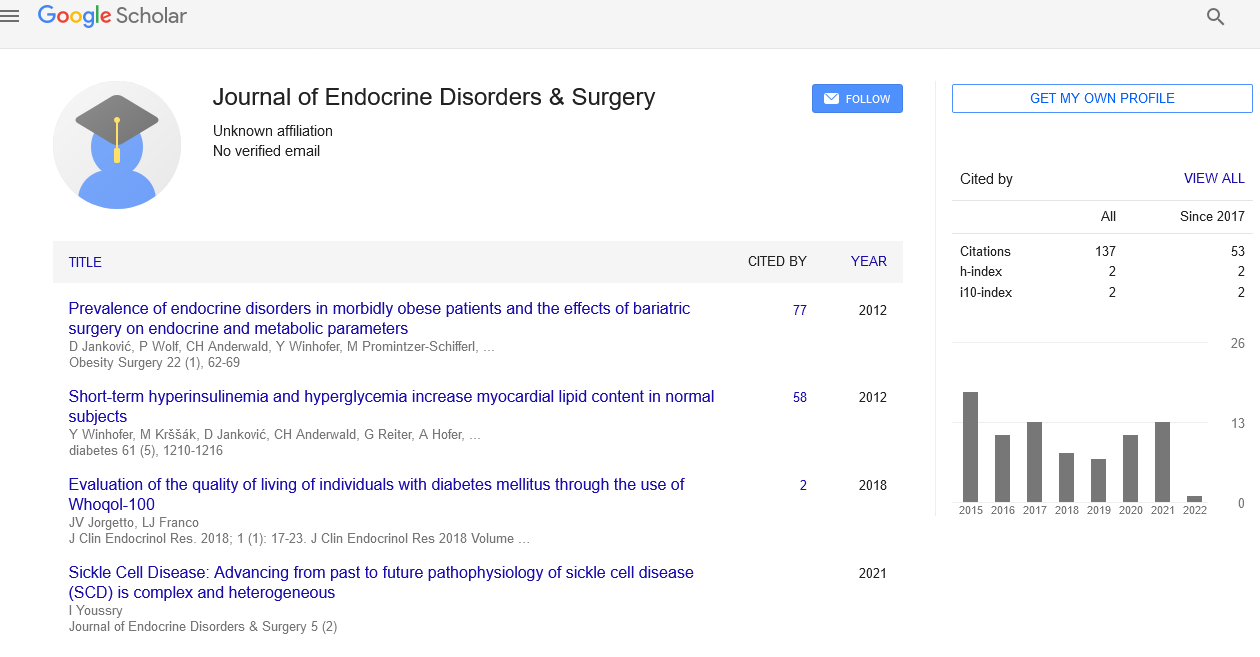Metabolic Homeostasis
Received: 04-Oct-2022, Manuscript No. PULJEDS-23-6203 ; Editor assigned: 06-Oct-2022, Pre QC No. PULJEDS-23-6203 (PQ); Accepted Date: Oct 25, 2022; Reviewed: 10-Oct-2022 QC No. PULJEDS-23-6203 (Q); Revised: 12-Oct-2022, Manuscript No. PULJEDS-23-6203 (R); Published: 30-Oct-2022, DOI: 10.37532/puljds.2022.6(5).06-07
Citation: James A. Metabolic Homeostasis. J. Endocr Disord Surg. 2022; 6(5):06-07
This open-access article is distributed under the terms of the Creative Commons Attribution Non-Commercial License (CC BY-NC) (http://creativecommons.org/licenses/by-nc/4.0/), which permits reuse, distribution and reproduction of the article, provided that the original work is properly cited and the reuse is restricted to noncommercial purposes. For commercial reuse, contact reprints@pulsus.com
Abstract
Energy must be continuously supplied to living things in order for them to survive. As a consequence, metabolic processes that extract energy from the environment and make it available to sustain life are the foundation of life as we know it (energy metabolism). The fundamental thermodynamics serves as the foundation for and the regulator of this metabolism. This is significant because kinetic parameters are extremely variable, whereas thermodynamic parameters are stable.
Keywords
Metabolic; Homeostasis; Regulation
Introduction
Near equilibrium processes that decide the thermodynamic control of metabolism the concentrations of small molecules that control the activity of irreversible reactions in metabolic pathways as well as the concentrations of metabolic substrates for enzymes that initiate irreversible steps. The end result is a strong homeostatic set point with practically endless stability over time. The rest of metabolism and its regulation are constrained to keep this set point. The ATP-producing step in glycolysis, glyceraldehyde-3- phosphate oxidation to pyruvate, serves as an example of thermodynamic regulation. The amount of fluid passing through the irreversible pyruvate kinase reaction is mainly governed by the rate of ATP oxidation. Mismatch between ATP use and production is brought on by changes in the rate of ATP usage. Through nearly equilibrium in the reactions that come before PK, the ensuing change in ATP/ADP/Pi modifies the concentrations of ADP and phosphoenolpyruvate, PK's substrates.
The various metabolic pathways are usually highlighted in descriptions of metabolism, and their regulation is covered in terms of kinetic control by specific reactions within the pathway. The focus is on locating the "rate-limiting steps" that are typically associated with reactions in the pathway that are irreversible, i.e., do not have a significant reverse reaction under physiological circumstances. In the current paper, we argue that focusing on kinetic control by modifying the activity of the enzymes catalysing the irreversible reactions in a metabolic pathway can be very deceptive and hinder the development of a more comprehensive knowledge of how metabolism works. Each cell's numerous metabolic pathways must work together cohesively in order for the cell to sustain life. Each pathway must work in concert and be complementary for individual cells to live. In order for each cell's numerous metabolic pathways to sustain life, they must work together cohesively. Each pathway must work in concert with and complement each other to create an integrated ensemble in order for individual cells to survive. Similar to this, each cell and tissue must work together with every other cell and tissue for a complex organism to live. The majority of the ATP-based energy needed for the survival of higher plants and mammals is produced by oxidative phosphorylation. Its incorporation into cellular metabolism is probably what allowed them to evolve their distinctive tissue division. Oxidative phosphorylation produces ATP with high efficiency and is tightly controlled over a broad range of rates. Importantly, oxidative phosphorylation has a built-in programme that controls and maintains the ATP/ADP/Pi cellular energy balance and, as a result, metabolic homeostasis. Understanding the regulation of energy metabolism in general is of great interest because of its crucial part in maintaining the environment as well as all facets of human health and food supply. This is not surprising because oxidative phosphorylation must adapt to a wide range in the rate of ATP consumption as muscle switches between rest and work, a range much larger than for any other tissue. Progress has been significantly hampered by the difficulty of obtaining measurements of metabolite concentrations and the rates at which they change that are adequately accurate and reliable. As long as the metabolite concentrations in the tissue sample do not change during or after the quenching event, metabolism can be halted (quenched) at a specific point in time and then measured. Creating a computational model is a crucial technique for researching complex systems, especially those that are poorly predicted by the available experimental data. Mathematical equations are used to predict behaviour in computational models, which are founded on empirical data. Utilizing recognised and hypothesised reactions and reaction mechanisms that are compatible with the available experimental data, the schema or model is built. The majority of the variables in the computational model should ideally have been measured separately. The factors that haven't been separately measured are then quantified by fitting the model's mathematical equations to the data on available metabolite measurements. The model can be used to simulate (predict) behaviour for circumstances where data are not yet available but are experimentally accessible once the mathematical predictions have been shown to be compatible with the data that is currently available. By finding the metabolites most crucial to comprehending control of the metabolism under study, such virtual experiments can enhance experimental results. The design of the experiment can then be improved to ensure that the measurements are those that will have the biggest impact on proving or disproving the model's underlying assumptions.





